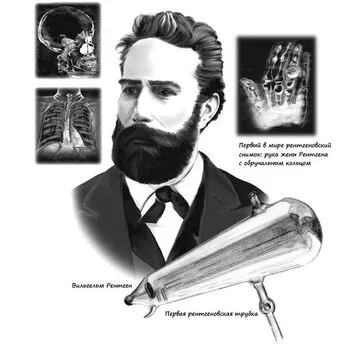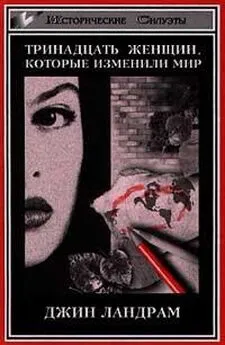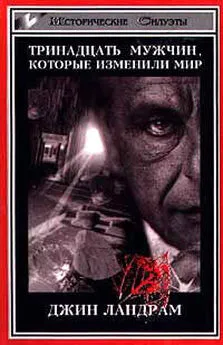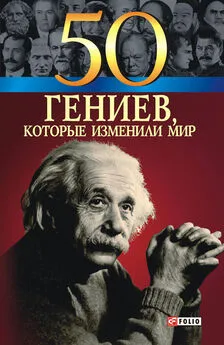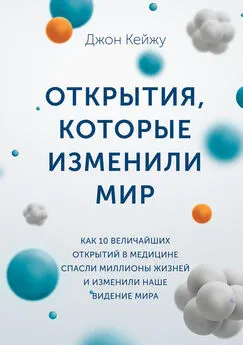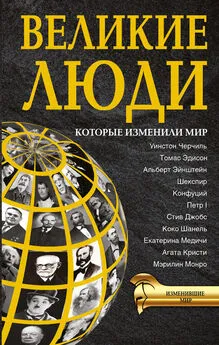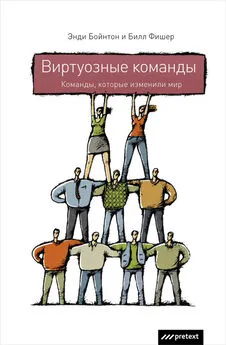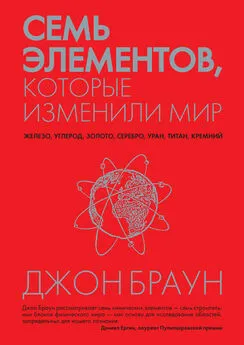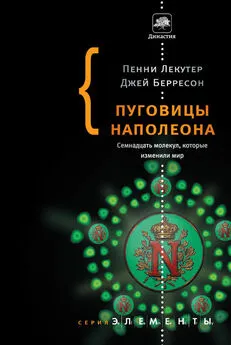Джон Кейжу - Открытия, которые изменили мир
- Название:Открытия, которые изменили мир
- Автор:
- Жанр:
- Издательство:Манн, Иванов и Фербер
- Год:2015
- ISBN:9785000578698
- Рейтинг:
- Избранное:Добавить в избранное
-
Отзывы:
-
Ваша оценка:
Джон Кейжу - Открытия, которые изменили мир краткое содержание
Открытия, которые изменили мир - читать онлайн бесплатно ознакомительный отрывок
Интервал:
Закладка:
Orser B. A. Lifting the fog around anesthesia // Scientific American, 2007. June. Pp. 54–61.
Rudolph U., Antkowiak B. Molecular and neuronal substrates for general anaesthetics // Nature Reviews. Neuroscience, 2004. Vol. 5, September. Pp. 709–720.
Smith W. D. A. A history of nitrous oxide and oxygen anaesthesia, Part I: Joseph Priestley to Humphry Davy // British Journal of Anaesthesia, 1965. Vol. 37. Pp. 790–798.
Snow J. On the Inhalation of the Vapour of Ether in Surgical Operations: Containing a Description of the Various States of Etherization. London: John Churchill, 1847.
Terrell R. C. The invention and development of enflurane, isoflurane, sevoflurane, and desflurane // Anesthesiology, 2008. Vol. 108. Pp. 531–533.
Thatcher V. S. History of Anesthesia, With Emphasis on the Nurse Specialist. New York: Garland Publishing, Inc, 1984.
Thoreau H. D. This Date, from Henry David Thoreau’s Journal: 1851 // http://hdt.typepad.com/henrys_blog/1851/index.html.
Thornton J. L. John Snow, Pioneer Specialist-Anaesthetist. John Snow website. Department of Epidemiology, School of Public Health, University of California, Los Angeles // www.ph.ucla.edu/epi/snow/anaesthesia5(5)_129_135_1950.pdf.
Катцунг Б. г. Базисная и клиническая фармакология: в 2-х т. М.: Бином, Диалект, 2007.
Глава 5
American Institute of Physics website. Marie Curie and the Science of Radioactivity // www.aip.org/history/curie/war1.htm.
Assmus A. Early History of X-Rays // BeamLine, 1995. Vol. 25. No. 2, Summer. Pp. 10–24.
Bowers B. X-rays: Their Discovery and Applications. London: Her Majesty’s Stationery Office 1970.
Brecher R., Brecher E. The Rays: A History of Radiology in the United States and Canada. Baltimore: The Williams and Wilkins Company, 1969.
Centers for Disease Control and Prevention. Mammography. National Center for Health Statistics, 2007. (Health, United States, Table 87) // www.cdc.gov/nchs/fastats/mammogram.htm.
Daniel T. M. Wilhelm Conrad Röntgen and the advent of thoracic radiology // The International Journal of Tuberculosis and Lung Disease, 2006. Vol. 10. No. 11. Pp. 1212–1214.
Doris C. I. Diagnostic imaging at its centennial: The past, the present, and the future // Canadian Medical Association Journal, 1995. Vol. 153. No. 9, November. Pp. 1297–1300.
Frame P. Coolidge X-ray Tubes // www.orau.org/PTP/collection/xraytubescoolidge/coolidgeinformation.htm.
Frankel R. I. Centennial of Röntgen’s discovery of X-rays // Western Journal of Medicine, 1996. Vol. 164. Pp. 497–501.
Glasser O. Wilhelm Conrad Röntgen and the Early History of the Roentgen Rays. Springfield, IL: Charles C. Thomas, 1934.
Hessenbruch A. X-rays for medical use // Physics Education, 1995. Vol. 30. No. 6, November. Pp. 347–355.
Kogelnik H. D. Inauguration of radiotherapy as a new scientific specialty by Leopold Freund 100 years ago // Radiotherapy and Oncology, 1997. Vol. 42. Pp. 203–211.
Lentle B., Aldrich J. Radiological sciences, past and present // The Lancet, 1997. Vol. 350, July. Pp. 280–285.
Linton O. W. Medical applications of X Rays // BeamLine, 1995. Vol. 25. No. 2, Summer. Pp. 25–34.
Mettler F. A., Jr. Essentials of Radiology, 2nd ed. Philadelphia: Elsevier Saunders, 2005.
Mould R. F. The early history of X-ray diagnosis with emphasis on the contributions of physics, 1895–1915 // Physics in Medicine and Biology, 1995. Vol. 40. Pp. 1741–1787.
New York Times. Dangers of x-ray: new investigation, following recent deaths, to insure scientists’ protection, 1921. May 15.
Nobelprize.org. Allan M. Cormack: The Nobel Prize in Physiology or Medicine, 1979 // http://nobelprize.org/nobel_prizes/medicine/laureates/1979/cormack-autobio.html.
Nobelprize.org. Godfrey N. Hounsfield: The Nobel Prize in Physiology or Medicine, 1979 // http://nobelprize.org/nobel_prizes/medicine/laureates/1979/hounsfield-autobio.html.
Nobelprize.org. Max von Laue: The Nobel Prize in Physics, 1914 // http://nobelprize.org/nobel_prizes/physics/laureates/1914/laue-bio.html.
Nobelprize.org. Wilhelm Conrad Röntgen: The Nobel Prize in Physics, 1901 // http://nobelprize.org/nobel_prizes/physics/laureates/1901/rontgen-bio.html.
Posner E. Reception of Röntgen’s discovery in Britain and U.S.A. // British Medical Journal, 1970. Vol. 4, November. Pp. 357–360.
Roentgen W. C. On a new kind of rays // Nature, 1896. Vol. 53. Pp. 274–277.
Schedel A. An unprecedented sensation — Public reaction to the discovery of x-rays // Physics Education, 1995. Vol. 30. No. 6, November. Pp. 342–347.
Suits C. G. William David Coolidge: Inventor, Physicist, Research Director // www.harvardsquarelibrary.org/unitarians/coolidge.html.
Sumner D. X-rays — Risks versus benefits // Physics Education, 1995. Vol. 30. No. 6, November. Pp. 338–342.
Wesolowski J. R., Lev M. H. CT: History, Technology, and Clinical Aspects // Seminars in Ultrasound, CT, and MRI, 2005. Vol. 26. Pp. 376–379.
Глава 6
Andre F. E. The future of vaccines, immunization concepts and practice // Vaccine, 2001. Vol. 19. Pp. 2206–2209.
Andre F. E. Vaccinology: Past achievements, present roadblocks, and future promises // Vaccine 2003. Vol. 21. Pp. 593–595.
Atkinson W., Hamborsky J., McIntyre L., Wolfe C., eds. Epidemiology and Prevention of Vaccine-Preventable Diseases, 10th ed. Centers for Disease Control and Prevention, 2008, February.
Barquet N., Pere D. Smallpox: The triumph over the most terrible of the ministers of death // Annals of Internal Medicine, 1997. Vol. 127. Pp. 635–642.
Baxter D. Active and passive immunity, vaccine types, excipients and licensing // Occupational Medicine, 2007. Vol. 57. Pp. 552–556.
Bazin H. The Eradication of Smallpox. San Diego: Academic Press, 2000.
Bazin H. A brief history of the prevention of infectious diseases by immunizations // Comparative Immunology, Microbiology & Infectious Diseases, 2003. Vol. 26. Pp. 293–308.
Behbehani A. M. The smallpox story: Life and death of an old disease // Microbiological Reviews, 1983. Vol. 47, December. Pp. 455–509.
Broome C. V. Testimony on eradication of infectious diseases. Доклад Американскому комитету по международным отношениям, 20 мая 1998 г. // www.hhs.gov/asl/testify/t980520a.html.
Centers for Disease Control and Prevention. Smallpox Overview // www.bt.cdc.gov/agent/smallpox/overview/disease-facts.asp.
Centers for Disease Control and Prevention. Some common misconceptions about vaccination and how to respond to them // www.cdc.gov/vaccines/vac-gen/6mishome.htm.
Clark P. F. Theobald Smith, Student of Disease (1859–1934) // Journal of the History of Medicine, 1959. October. Pp. 490–514.
Dunlop D. R. The life and work of Louis Pasteur // The Canadian Medical Association Journal, 1928. Vol. 18. No. 3, March. Pp. 297–303.
Fleming A. Louis Pasteur // British Medical Journal, 1947. April 19. Pp. 517–522.
Hammarsten J. F., Tattersall W., Hammarsten J. E. Who discovered smallpox vaccination? Edward Jenner or Benjamin Jesty? // Transactions of the American Clinical and Climatological Association, 1979. Vol. 90. Pp. 44–55.
Hilleman M. R. Vaccines in historic evolution and perspective: A narrative of vaccine discoveries // Vaccine, 2000. Vol. 18. Pp. 1436–1447.
Huygelen C. The concept of virus attenuation in the eighteenth and early nineteenth centuries // Biologicals, 1997. Vol. 25. Pp. 339–345.
Jenner E. An Inquiry Into the Causes and Effects of the Variolae Vaccinae, Or Cow-Pox. 1798 // www.bartleby.com/38/4/1.html.
Kaufmann S. H. E. Immunology’s foundation: The 100-year anniversary of the Nobel Prize to Paul Ehrlich and Elie Metchnikoff // Nature Immunology, 2008. Vol. 9. No. 7, July. Pp. 705–712.
Krasner R. Pasteur: High priest of microbiology // The American Society for Microbiology. ASM News, 1995. Vol. 61. No. 11. Pp. 575–578.
Li Y., Carroll D. S., Gardner S. N. et al. On the origin of smallpox: Correlating variola phylogenics with historical smallpox records // Proceedings of the National Academy of Sciences of the United States of America, 2007. Vol. 104. No. 40, October. Pp. 15,787–15,792.
Mullin D. Prometheus in Gloucestershire: Edward Jenner, 1749–1823 // The Journal of Allergy and Clinical Immunology, 2003. Vol. 112. No. 4, October. Pp. 810–814.
Nobelprize.org. Emil von Behring: The Nobel Prize in Physiology or Medicine, 1901 // http://nobelprize.org/nobel_prizes/medicine/laureates/1901/behring-bio.html.
Nobelprize.org. Ilya Mechnikov: The Nobel Prize in Physiology or Medicine, 1908 // http://nobelprize.org/nobel_prizes/medicine/laureates/1908/mechnikov-bio.html.
Nobelprize.org. Paul Ehrlich: The Nobel Prize in Physiology or Medicine, 1908 // http://nobelprize.org/nobel_prizes/medicine/laureates/1908/ehrlich-bio.html.
Offit P. A. Thimerosal and vaccines — A cautionary tale // The New England Journal of Medicine, 2007. Vol. 357. No. 13, September. Pp. 1278–1279.
Pasteur M. An address on vaccination in relation to chicken cholera and splenic fever // The British Medical Journal, 1881. August. Pp. 283–284.
Pead P. J. Benjamin Jesty: New light in the dawn of vaccination // The Lancet, 2003. Vol. 362, December. Pp. 2104–2109.
Plotkin S. A. Vaccines: Past, present, and future // Nature Medicine Supplement, 2005. Vol. 11. No. 4, April. Pp. S5–S11.
Plotkin S. A., Orenstein W. A., Offit P. A., eds. Vaccines, 4th edition. Philadelphia: Saunders, 2004.
Schwartz M. The life and works of Louis Pasteur // Journal of Applied Microbiology, 2001. Vol. 91. Pp. 597–601.
Stern A. M., Markel H. The history of vaccines and immunization: Familiar patterns, new challenges // Health Affairs, 2005. Vol. 24. No. 3, May/June. Pp. 611–621.
U. S. Food and Drug Administration. FDA Approves New Smallpox Vaccine, September 4, 2007 // www.fda.gov/consumer/updates/smallpox090407.html.
Глава 7
Arias C. A., Murray B. E. Antibiotic-resistant bugs in the 21st century — A clinical super-challenge // The New England Journal of Medicine, 2009. Vol. 360. January 29. Pp. 439–443.
Bassett E. J., Keith M. S., Armelagos G. J. et al. Tetracycline-labeled human bone from ancient Sudanese Nubia (A.D. 350) // Science, 1980. Vol. 209. No. 4464, September 26. Pp. 1532–1534.
Bentley S. D., Chater K. F., Cerdeño-Tárraga A. M. et al. Complete genome sequence of the model actinomycete Streptomyces coelicolor A3(2) // Nature, 2002. Vol. 417, May 9. Pp. 141–147.
Brunel J. Antibiosis from Pasteur to Fleming // Journal of the History of Medicine and Allied Sciences, 1951. Vol. 6. No. 3, Summer. Pp. 287–301.
Capasso L. Infectious diseases and eating habits at Herculaneum (1st Century AD, Southern Italy) // International Journal of Osteoarchaeology, 2007. Vol. 17. Pp. 350–357.
Centers for Disease Control and Prevention. Environmental Management of Staph and MRSA in Community Settings // www.cdc.gov/ncidod/dhqp/ar_mrsa_Enviro_Manage.html.
Centers for Disease Control and Prevention. Healthcare-Associated Methicillin Resistant Staphylococcus aureus (HA-MRSA) // www.cdc.gov/ncidod/dhqp/ar_mrsa.html.
Chain E., Florey H. W. The discovery of the chemotherapeutic properties of penicillin // British Medical Bulletin, 1944. Vol. 2. No. 1. Pp. 5–6.
Читать дальшеИнтервал:
Закладка:
